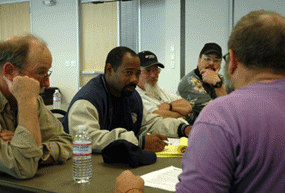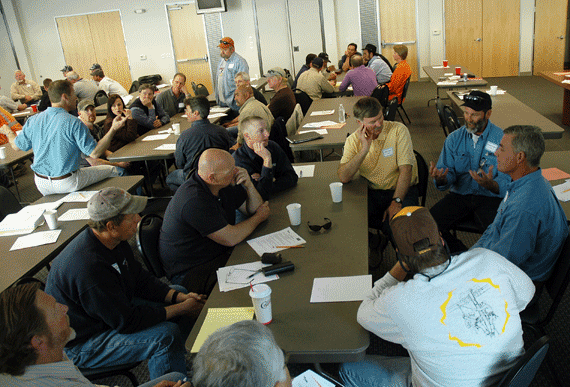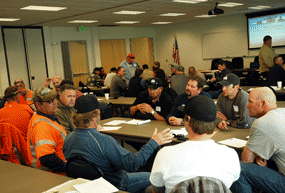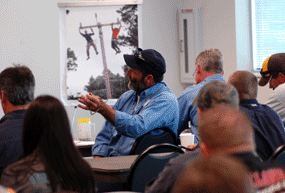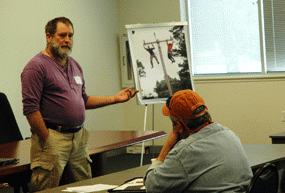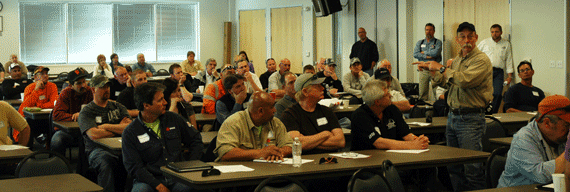
Willie Bouzek, standing right, jumps into the discussion at the April 1 conference at Weakley Hall on line safety.
About 60 Local 1245 linemen from various employers met in Vacaville on April 1, 2010 to start creating a linemen-to-linemen safety program.
The linemen gathering–the third such meeting in less than a year devoted specifically to line safety concerns–was given special urgency by the death of PG&E Lineman Max Martinez on March 17.
The accident scene was described at the start of the meeting by Troubleman John Kent, who responded to the trouble call and then served as steward for the interviews.
Martinez discussed the job with his truck driver on the way to the jobsite, Kent said.
“We built this box last week. It’s hot today. You be careful,” said Kent, his quiet voice filling the hushed room as he reconstructed one of the last conversations Martinez would ever have. “That’s Max, telling his buddy the truck driver who has less time than him: ‘You be careful. We know it’s hot.’ ”
Twenty minutes later, said Kent, after they had set out the cones, Max was dead.
“Those are the facts. That’s what happened. What led up to it, what will happen after that, the investigation is still going on. But I now have the experience of helping a fireman put a toe tag on a lineman, and I tell you I will never forget that,” Kent said.
Consultants Jeff “Odie” Espenship, a retired Air Force fighter pilot, and Wes Sharp, a safety expert from the USMC aviation program, then made presentations that focused on the concept of “knock it off,” a term used in aviation that anyone can use to abort a maneuver if something doesn’t seem right. It quickly became clear that no comparable mechanism exists for a lineworker who is uneasy about some aspect of a job situation.
The linemen compiled a lengthy list of items that contribute to making job sites more hazardous. Just a few of the items mentioned:
Cell phone use, leading to inattention.
Excessive discipline, making people reluctant to discuss “near-misses.”
Talking during tailboards.
Violation of safety rules.
Inadequate tools.
Belittling extra safety.
Inadequate staffing.
The linemen continued the discussion in small groups. The groups, all meeting in the same room, generated a small roar as the linemen traded stories, questions, ideas, proposals. Mid-afternoon they reconvened to share what they had discussed. And in those reports you could begin to see the vague outline of a program starting to come into focus. A program by linemen, for linemen, to keep linemen safe on the job.